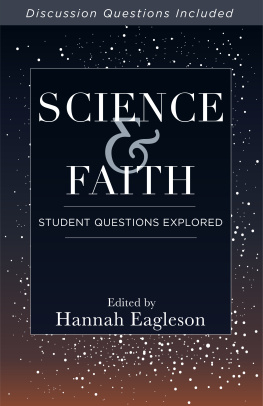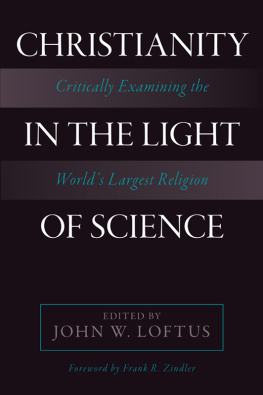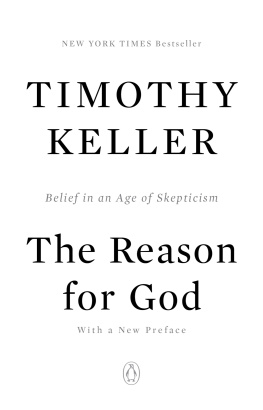Copyright 2019 Fortress Press, an imprint of 1517 Media. All rights reserved. Except for brief quotations in critical articles or reviews, no part of this book may be reproduced in any manner without prior written permission from the publisher. Email copyright@1517.media or write to Permissions, Fortress Press, PO Box 1209, Minneapolis, MN 55440-1209.
The paper used in this publication meets the minimum requirements of American National Standard for Information Sciences Permanence of Paper for Printed Library Materials, ANSI Z329.48-1984.
Manufactured in the U.S.A.
2
Introduction: What This Book Is about and How It Works
Years ago, on a clear October evening, I saw Uranus with my naked eye. My lab assistant and I stayed behind at the college observatory after all the Astronomy 101 students had departed for the night, and we devoted ourselves to the project. It took some effort, but we both succeeded in spotting the seventh planet amid the stars scattered along the Aquarius-Pisces boundary, with no help from binoculars or telescopes.
Uranus sits just this side of visibility and moves slowly, taking eighty-four years to complete a single lap around the sun. For these reasons, it spent many years cataloged as a star. Then, in 1781, an Englishman named William Herschel observed it through his homemade telescope, thought it looked odd, and recorded it as a comet. Within a couple of years, however, astronomers overruled this assignment and announced the first discovery of a planet in recorded history.
Herschel named it George. Non-British astronomers, uninterested in honoring King George III of England, werent having it. Scientists haggled over the name for decades, and the planet was finally given its permanent moniker in 1850. Uranus jokes began appearing in print shortly thereafter.
In order to see Uranus with your naked eye, you must meet certain requirements. First, you need to be under a truly dark sky. Humidity, city lights, moonlight, or any combination of these brighten the sky so much that Uranus will be wiped clean out. You must also have excellent vision, a star chart showing the exact location of Uranus among the stars at the time of observation, and plenty of patience.
With all this, however, you could still look and look and look and not spot it. In fact, you could stare directly at Uranus for hours without knowing it. The source of this puzzlement dwells not in the heavens but in your eye. The human retina contains two kinds of light-detecting cells, cones and rods. Cones respond to colors and bright lights and are concentrated at the center of the retina, opposite the lens. Rods detect low levels of light and are spread out around the cones. When you look at Uranus straight on, the light falls on the cones, but the planet glows too faintly to be detected by these cells. Youll never see Uranus by looking at it.
But if you look just to the side of it, its light falls on your rods, and the planet pops into view. Once this happens, you instinctively move your eye back toward it and, poof, it disappears again. Resisting this reflex feels weird at first, but with practice, the technique becomes natural. Experienced stargazers are accustomed to using this so-called averted vision to see dim objects.
Much as some things can be seen not by looking at them but by looking at what is next to them, some things can be understood not by thinking about them but by thinking about what is next to them. The more you think about these things or try to figure them out or nail them down, the more elusive they become. They cant be grasped by head-on thinking. But if you relax a little and think to the side, you might come to know what you could never comprehend directly.
Take God, for example. We all want to know and understand God, but the Lord is tough to get a fix on. Just ask Moses. He was pretty tight with Yahweh, but despite asking for more, and asking nicely, he never got to see more than Gods backside. Mostly God appeared to Moses as something else: a burning bush, a pillar of fire, a cloud. Isaiah saw the lining of Gods robes, not God. Jacob wrestled with God in the form of a man he couldnt see, and angels often stand in the gap between God and human beings.
In addition to offering us such stories, Scripture tells us plainly that God abides beyond understanding and creates beyond imagination: For my thoughts are not your thoughts, nor are your ways my ways, says the Lord. For as the heavens are higher than the earth, so are my ways higher than your ways and my thoughts than your thoughts (Isaiah 55:89). Given all this, our gaining insight into God appears as unlikely as a panda gaining insight into particle physics. The gap between us and the Creator seems impossibly wide.
But God desires to be present with us. Jesus, of course, manifests that desire. But Im convinced that we may also find the Creator in the world around us. Like averting ones vision in order to see Uranus, we can glimpse God by relaxing our eyes a little and looking at whats next to Goda friend, a community, a bird, a landscape, a cosmos.
But its not so easy, is it? Over the centuries, weve looked closer and closer at the universe and its contents, and many people havent glimpsed God in it, or next to it, or anywhere else for that matter. In fact, scientiststhe very ones who have done the most careful and systematic looking at what I claim is next to Godare relatively unlikely to believe in God at all. Some prominent scientists have even made careers out of speaking and writing against God. They believe science demonstrates that, like the emperor in the folk tale, faith spends its days marching around the town square with no clothes on.
Some believers seem to agree. They, too, think science removes God from the world, so they work hard to discredit science. Many Christians have singled out the big bang and evolution as particular threats to true faith. Also, plenty of nonscientists and nonbelievers look at the news, see headlines about the conflict between faith and science, and assume the two naturally oppose one another or, at best, have nothing helpful to say to each other.
So if we can see God by looking at the world, why is it so many people dont?
I can think of two reasons. First, many people hold an unrealistic view of science, believing it provides an unbiased and comprehensive view of reality. Beyond this, certain public voices claim not only that science reveals the truth but also that it alone has the capacity to do so.
This is false. When we view the cosmos through the lenses of science, we see an incomplete picture, because those lenses filter out certain aspects of the world the way sunglasses filter out certain wavelengths of light. For example, virtues such as faith, hope, and loveas well as their shadow sides of distrust, despair, and fearare blocked by the shades of science. About these values, science has nothing to report. In the eyes of science, in fact, they dont even exist.
But if the lenses of science work like sunglasses, they work like prescription sunglasses: they sharpen and refine what we can see through them. We dont need science to know about faith, hope, and love, but wed never be aware of such realities as evolution, atoms, and quasars without it.









